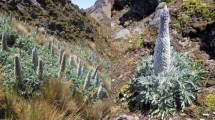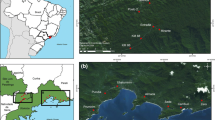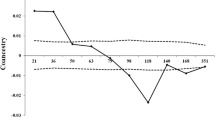Abstract
It is important to optimize strategies for collecting wild germplasm from their natural habitats for the successful conservation of plant genetic resources. We studied the population structure of three predominantly self-pollinating wild Lactuca species (Lactuca serriola, L. saligna, and L. aculeata). Seeds for this study were collected from individual plants in northern Israel, along a line transect, and two populations per each Lactuca species. The distance between neighboring plants sampled for seeds varied from 1.5 to 37 m. The transect length at single sites ranged from 47.2 to 151.8 m. The taxonomic status of 67 individual plants was morphologically validated during greenhouse multiplication. Both genetic structure and diversity were analyzed by using 11 EST–SSR loci and 230 AFLP markers. Relatively low genetic diversity values were observed, increasing in the following order: L. aculeata < L. serriola < L. saligna. Network analysis clearly separated samples according to their taxonomic determination; also reflecting the gene diversity as well as the genetic distance values among the three species. Nevertheless, given the predominantly selfing character of these species, populations were not uniform (genetically and morphologically). It seems that overall genetic variation in a population increases at its periphery, due to the presence of plants with “non-indigenous” alleles, which are most likely coming from migration and subsequent interpopulation or interspecific hybridization. Mantel tests generally indicated a positive association between genetic distance and micro-geographical distance of a particular population, primarily due to the “outlier” samples collected at a population’s periphery.


Similar content being viewed by others
References
Anderson E (1948) Hybridization of the habitat. Evolution 2:1–9
Arnold M, Martin N (2010) Hybrid fitness across time and habitats. Trends Ecol Evol 25:530–536
Arnold ML, Sapir Y, Martin NH (2008) Genetic exchange and the origin of adaptations: prokaryotes to primates. Philos Trans R Soc Lond Ser B Biol Sci 363:2813–2820
Baskett ML, Gomulkiewicz R (2011) Introgressive hybridization as a mechanism for species rescue. Theor Ecol 4:223–239
Beharav A, Ben-David R, Doležalová I, Lebeda A (2008) Eco-geographical distribution of Lactuca saligna natural populations in Israel. Israel J Plant Sci 56:195–206
Beharav A, Ben-David R, Doležalová I, Lebeda A (2010a) Eco-geographical distribution of Lactuca aculeata natural populations in north-eastern Israel. Genet Resour Crop Evol 57:679–686
Beharav A, Ben-David R, Malarz J, Stojakowska A, Michalska K, Doležalová I, Lebeda A, Kisiel W (2010b) Variation of sesquiterpene lactones in Lactuca aculeata natural populations from Israel, Jordan and Turkey. Biochem Syst Ecol 38:602–611
Beharav A, Ochoa O, Michelmore R (2014) Resistance in natural populations of three wild Lactuca species from Israel to highly virulent Californian isolates of Bremia lactucae. Genet Resour Crop Evol 61:603–609
Brown AHD, Marshall DR (1995) A basic sampling strategy: theory and practice. In: Guarino L, Rao VR, Reid R (eds) Collecting plant genetic diversity, technical guidelines. CAB International, Oxon, pp 75–91
Bryant D, Moulton V (2004) Neighbor-Net: an agglomerative method for the construction of phylogenetic networks. Mol Biol Evol 21:255–265
Cavalli-Sforza LL, Edwards AWF (1967) Phylogenetic analysis: models and estimation procedures. Evolution 21:550–570
Crow JF, Kimura M (1970) An introduction to population genetics theory. Burgess, Minneapolis
D’Andrea L, van deWiel C, Meirmans P, Guadagnuolo R, Kozlowski G, den Nijs H, Felber F (2006) Molecular biogeography of prickly lettuce (L. serriola L.) in Europe based on nuclear microsatellites and chloroplast DNA polymorphism, In: D’Andrea L, Historical and molecular biogeography of prickly lettuce (L. serriola L.) and evaluation of hybridisation with the crop (L. sativa L.). Ph.D. Thesis, Department of Botany, University of Neuchatel, Switzerland, pp 41–68
D’Andrea L, Felber F, Guadagnuolo R (2008) Hybridization rates between lettuce (Lactuca sativa) and its wild relative (L. serriola) under field conditions. Environ Biosaf Res 7:61–71
de Vries IM (1997) Origin and domestication of Lactuca sativa L. Genet Resour Crop Evol 44:165–174
Dice LR (1945) Measures of the amount of ecologic association between species. Ecology 26:297–302
Doležalová I, Křístková E, Lebeda A, Vinter V (2002) Description of morphological characters of wild Lactuca L. spp. genetic resources (English–Czech version). Hort Sci (Prague) 29:56–83
Doležalová I, Křístková E, Lebeda A, Vinter V, Astley D, Boukema IW (2003) Basic morphological descriptors for genetic resources of wild Lactuca spp. Plant Genet Resour Newsletter 134:1–9
Dowling TE, Secor CL (1997) The role of hybridization and introgression in the diversification of animals. Annu Rev Ecol Syst 28:593–619
Excoffier L, Lischer H (2010) Arlequin suite ver 3.5: a new series of programs to perform population genetics analyses under Linux and Windows. Mol Ecol Res 10:564–567
Feinbrun-Dothan N (1978) Flora Palestina. Part 3 (text). Israel Academy of Sciences and Humanities, Jerusalem, Israel
Felsenstein J (1985) Confidence limits on phylogenies: an approach using the bootstrap. Evolution 39:783–791
Feráková V (1977) The genus Lactuca in Europe. Univerzita Komenského, Bratislava
Fitch W (1997) Networks and viral evolution. J Mol Evol 44:S65–S75
Grulich V (2004) Lactuca L.—locika. In: Slavík B, Štěpánková J (eds) Květena České republiky, díl 7. Academia, Praha, pp 487–497
Hardy OJ, Vekemans X (2002) SPAGeDi: a versatile computer program to analyse spatial genetic structure at the individual or population levels. Mol Ecol Notes 2:618–620
Huson DH, Bryant D (2006) Application of phylogenetic networks in evolutionary studies. Mol Biol Evol 23:254–267
Jemelková M, Kitner M, Lebeda A, Sahajová E, Křístková E, Beharav A (2013) Genetic variability of Lactuca aculeata germplasm expressed by AFLP and SSR markers, and by resistance variation against Bremia lactucae. In: Lebeda A, Burdon JJ (eds) Wild plant pathosystems. Programme and proceedings of abstracts, 1st International Conference. Czech Society for Plant Pathology and Palacký University, Olomouc (Czech Republic), pp 91–92
Kilian N, Gemeinholzer B, Lack HW (2009) Cichorieae. In: Funk VA, Susanna A, Stuessy T, Bayer R (eds) Systematics, evolution, and biogeography of the Compositae. International Association for Plant Taxonomy, Vienna, pp 343–383
Kitner M, Lebeda A, Doležalová I, Maras M, Křístková E, Nevo E, Pavlíček T, Meglic V, Beharav A (2008) AFLP analysis of Lactuca saligna germplasm collections from four European and three Middle East countries. Israel J Plant Sci 56:185–193
Křístková E, Doležalová I, Lebeda A (2009) Morphological grouping of Lactuca saligna germplasm originating from Italy and France. In: Meglic V, Bastar MT (eds) Book of abstracts of 19th EUCARPIA Conference, Genetic Resources Section, Ljubljana, Slovenia, May 26–29, 2009. Kmetijski Institut Slovenije, Ljubljana, Slovenia, p 46
Křístková E, Lebeda A, Doležalová I, Kitner M, Petrželová I, Mieslerová B, Korbelová P, Šmachová P, Beharav A, Nevo E, Ben David R, Meglic V, Maras M (2010) Willow-leaf lettuce—distribution and variation, In: Dolenc Koce J, Vodnik D, Pongrac P (eds) Book of abstracts, 5th Slovenian Symposium on Plant Biology with International Participation, September 6–8 2010, Ljubljana, Slovenia, The Slovenian Society of Plant Biology, p 47
Křístková E, Lebeda A, Kitner M, Vafková B, Matoušková Z, Doležalová I, Beharav A (2012) Phenotypes of the natural interspecific hybrids in the genus Lactuca. Úroda 60(9):28–31
Křístková E, Lebeda A, Novotná A, Doležalová I, Berka T (2014) Morphological variation of Lactuca serriola L. achenes as a function of their geographic origin. Acta Botanica Croatica 73:1–19
Langella O (2002) Populations 1.2.28. Population genetic software (individuals or populations distances, phylogenetic trees). (http://bioinformatics.org/~tryphon/populations/)
Lebeda A, Doležalová I, Křístková E, Mieslerová B (2001) Biodiversity and ecogeography of wild Lactuca spp. in some European countries. Genet Resour Crop Evol 48:153–164
Lebeda A, Doležalová I, Astley D (2004a) Representation of wild Lactuca spp. (Asteraceae, Lactuceae) in world genebank collections. Genet Resour Crop Evol 51:167–174
Lebeda A, Doležalová I, Feráková V, Astley D (2004b) Geographical distribution of wild Lactuca species (Asteraceae, Lactuceae). The Botanical Rev 70(3):328–356
Lebeda A, Doležalová I, Křístková E, Dehmer KJ, Astley D, van de Wiel CCM, van Treuren R (2007a) Acquisition and ecological characterization of Lactuca serriola L. germplasm collected in the Czech Republic, Germany, the Netherlands and United Kingdom. Genet Resour Crop Evol 54:555–562
Lebeda A, Ryder EJ, Grube R, Doležalová I, Křístková E (2007b) Lettuce (Asteraceae; Lactuca spp.). In: Singh R (ed) Genetic resources, chromosome engineering, and crop improvement series, volume 3—vegetable crops. CRC Press, Boca Raton, pp 377–472
Lebeda A, Doležalová I, Křístková E, Kitner M, Petrželová I, Mieslerová B, Novotná A (2009a) Wild Lactuca germplasm for lettuce breeding: current status, gaps and challenges. Euphytica 170:15–34
Lebeda A, Kitner M, Dziechciarková M, Doležalová I, Křístková E, Lindhout P (2009b) An insight into the genetic polymorphism among European populations of Lactuca serriola assessed by AFLP. Biochem Syst Ecol 37:597–608
Lebeda A, Doležalová I, Kitner M, Novotná A, Šmachová P, Widrlechner MP (2011) North American Continent—a new source of wild Lactuca spp. germplasm variability for future lettuce breeding. Acta Hortic 918:475–482
Lebeda A, Doležalová I, Novotná A (2012a) Wild and weedy Lactuca species, their distribution, ecogeography and ecobiology in USA and Canada. Genet Resour Crop Evol 59:1805–1822
Lebeda A, Kitner M, Křístková E, Doležalová I, Beharav A (2012b) Genetic polymorphism in Lactuca aculeata populations and occurrence of natural putative hybrids between L. aculeata and L. serriola. Biochem Syst Ecol 42:113–123
Lebeda A, Mieslerová B, Petrželová I, Korbelová P, Česneková E (2012c) Patterns of virulence variation in the interaction between Lactuca spp. and lettuce powdery mildew (Golovinomyces cichoracearum). Fungal Ecol 5:670–682
Lebeda A, Mieslerová B, Petrželová I, Korbelová P (2013) Host specificity and virulence variation in populations of lettuce powdery mildew pathogen (Golovinomyces cichoracearum s. str.) from prickly lettuce (Lactuca serriola). Mycol Progr 12:533–545
Lebeda A, Křístková E, Kitner M, Mieslerová B, Jemelková M, Pink DAC (2014) Wild Lactuca species, their genetic diversity, resistance to diseases and pests, and exploitation in lettuce breeding. Eur J Plant Pathol 138:597–640
Lewontin RC, Birch LC (1966) Hybridization as a source of variation for adaptation to new environments. Evolution 20:315–336
Lindqvist K (1960) On the origin of cultivated lettuce. Hereditas 46:319–350
Lu YQ, Baker J, Preston C (2007) The spread of resistance to acetolactate synthase inhibiting herbicides in wind borne, self-pollinated weed species, Lactuca serriola L. Theor Appl Genet 115:443–450
Maggioni L, Lebeda A, Boukema I, Lipman E (compilers) (2008) Report of a working group on leafy vegetables. First meeting, 13–14 October 2005, Olomouc, Czech Republic. Bioversity International, Rome, Italy
Maggioni L, van Treuren R, Lohwasser U, Lipman E (2014) Report of a working group on leafy vegetables. Second meeting, 8–9 October 2013, Ljubljana, Slovenia. Bioversity International, Rome, Italy
Majeský L, Vašut R, Kitner M, Trávníček B (2012) The pattern of genetic variability in apomictic clones of Taraxacum officinale indicates the alternation of asexual and sexual histories of apomicts. PLoS ONE 7(8):e41868
Mantel NA (1967) The detection of disease clustering and a generalized regression approach. Cancer Res 27:209–220
McCouch S (2013) Feeding the future. Nature 499(4):23–24
Nei M (1978) Estimation of average heterozygosity and genetic distance from a small number of individuals. Genetics 89:583–590
Novotná A, Doležalová I, Lebeda A, Kršková M, Berka T (2011) Morphological variability of achenes of some European populations of Lactuca serriola L. Flora 206:473–483
Nybom H, Weising K, Rotter B (2014) DNA fingerprinting in botany: past, present, future. Investig Genet 5:1
Pavlíček BA, Hrda S, Flegr J (1999) FreeTree—freeware program for construction of phylogenetic trees on the basis of distance data and bootstrap/jackknife analysis of the tree robustness, application in the RAPD analysis of the genus Frenkelia. Folia Biol Prague 45:97–99
Peakall R, Smouse PE (2012) GenAlEx 6.5: genetic analysis in excel. Population genetic software for teaching and research-an update. Bioinformatics 28:2537–2539
Petrželová I, Lebeda A (2011) Distribution of race-specific resistance against Bremia lactucae in natural populations of Lactuca serriola. Eur J Plant Pathol 129:233–253
Petrželová I, Lebeda A, Beharav A (2011) Resistance to Bremia lactucae in natural populations of Lactuca saligna from some Middle Eastern countries and France. Ann Appl Biol 159:442–455
Riar DS, Rustgi S, Burke IC, Gill KS, Yenish JP (2011) EST–SSR development from 5 Lactuca species and their use in studying genetic diversity among L. serriola biotypes. J Hered 102:17–28
Rick CM, Fobes JF, Holle M (1977) Genetic variation in Lycopersicon pimpinellifolium: evidence of evolutionary change in mating systems. Plant Syst Evol 127:139–170
Rieseberg LH, Raymond O, Rosenthal DM, Lai Z, Livingstone K, Nakazato T, Durphy JL, Schwarzbach AE, Donovan LA, Lexer C (2003) Major ecological transitions in wild sunflowers facilitated by hybridization. Science 301:1211–1216
Schlüter PM, Harris SA (2006) Analysis of multilocus fingerprinting data sets containing missing data. Mol Ecol Notes 6:569–572
Simko I (2009) Development of EST–SSR markers for the study of population structure in lettuce (Lactuca sativa L.). J Hered 100:256–262
Spooner DM, van der Berg RG (1992) An analysis of recent taxonomic concepts in wild potatoes (Solanum sect. Petota). Genet Resour Crop Evol 39:23–37
Stebbins GL (1957) Self—fertilization and population variability in the higher plants. Am Nat 91:337–354
Stojakowska A, Michalska K, Malarz J, Beharav A, Kisiel W (2013) Root tubers of Lactuca tuberosa as a source of antioxidant phenolic compounds and new furofuran lignans. Food Chem 138:1250–1255
van Hintum TJL (2003) Molecular characterization of a lettuce germplasm collection. In: van Hintum TJL, Lebeda A, Pink D, Schut JW (eds) Eucarpia leafy vegetables 2003. Centre for Genetic Resources, Wageningen, pp 99–104
Vos P, Hogers R, Bleeker M, Reijans M, van de Lee T, Hornes M, Frijters A, Pot J, Peleman J, Kuiper M, Zabeau M (1995) AFLP: a new technique for DNA fingerprinting. Nucl Acids Res 23:4407–4414
Zamir D (2008) Plant breeders go back to nature. Nat Genet 40:269–270
Zohary D (1991) The wild genetic resources of cultivated letucce (Lactuca sativa L.). Euphytica 53:31–35
Acknowledgments
M.K., L.M., E.K., M.J., A.L. were supported by the Internal Grant Agency of Palacký University in Olomouc (PrF-2013-003, and IGA_Prf_2014001), Project MSM 6198959215 (Ministry of Education, Youth and Sports), and Project QH 71254 (Czech Ministry of Agriculture); and LM was supported by the European Social Fund, Education for Competitiveness Operational Programme (CZ.1.07/2.3.00/30.0004). AB wishes to thank the Research Authority, University of Haifa, Israel for financial support for the collection of Lactuca germplasm. The authors wish to thank Mrs. Drahomíra Vondráková (Palacký University in Olomouc), Ms. Souad Khalifa (University of Haifa) for their technical assistance, and anonymous reviewer for constructive comments and suggestions which helped us to improve the manuscript.
Author information
Authors and Affiliations
Corresponding author
Rights and permissions
About this article
Cite this article
Kitner, M., Majeský, L., Křístková, E. et al. Genetic structure and diversity in natural populations of three predominantly self-pollinating wild Lactuca species in Israel. Genet Resour Crop Evol 62, 991–1008 (2015). https://doi.org/10.1007/s10722-014-0203-5
Received:
Accepted:
Published:
Issue Date:
DOI: https://doi.org/10.1007/s10722-014-0203-5




